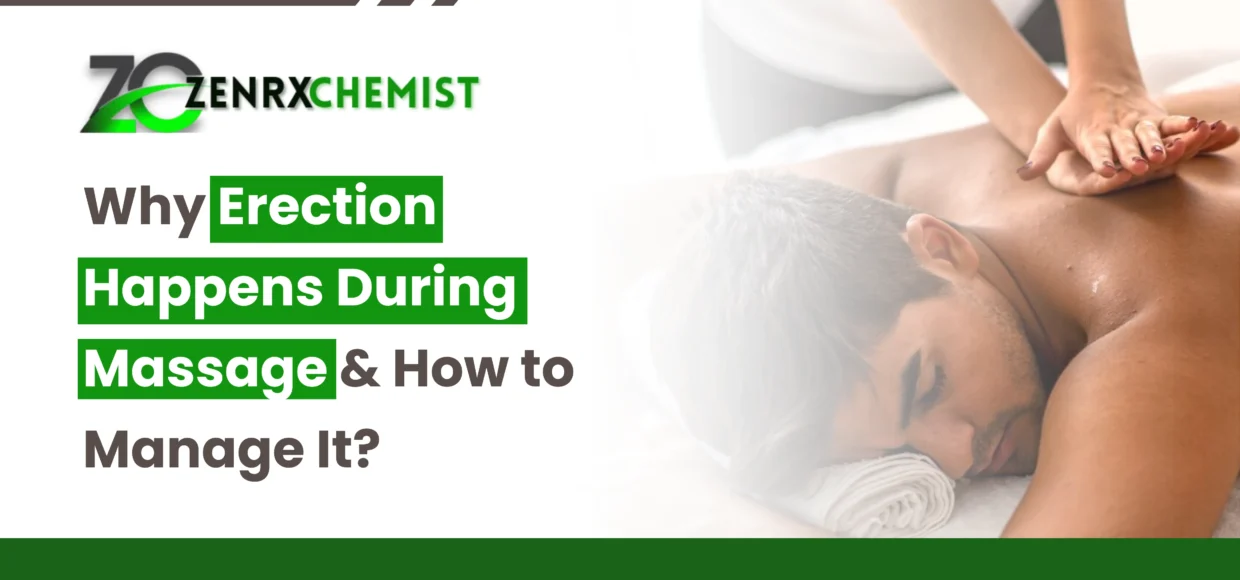Blog
Why Erection Happens During Massage and How to Manage It?
An erection during a massage can be an unexpected and often embarrassing occurrence. Many men experience this involuntarily due to the body’s natural response to touch, relaxation, and nervous system activation. While some feel uncomfortable, it is essential to understand the physiological and psychological aspects behind this phenomenon.
This article explores why it happens, when it is normal, and how to manage it professionally during a therapeutic massage session.
What is an Erection in Men?
An erection occurs when the penile blood vessels dilate, increasing blood flow to the corpora cavernosa. This process is regulated by the parasympathetic nervous system, which activates in response to physical or psychological stimuli. Erections are natural and can happen even without sexual arousal, especially in states of deep relaxation.
Why Does an Erection Happen During a Massage?
Parasympathetic Nervous System Activation
Massage therapy relaxes the body, triggering the parasympathetic nervous system. This system controls involuntary body functions, including vasodilation, which can lead to an erection.
Increased Blood Flow and Circulation
The massage table positions the body in a way that improves circulation. Increased blood flow to different body parts, including the genitals, may cause an erection without sexual intent.
Release of Relaxation Hormones
Massage stimulates the release of oxytocin and endorphins, hormones that promote relaxation and emotional well-being. This relaxation may lead to unintended physiological responses.
Sensitive Nerve Endings
The skin has millions of nerve endings, and some areas are more sensitive than others. If these nerves are stimulated during a massage session, it can lead to an erection, even in a non-sexual context.
Psychological Factors
Anxiety, embarrassment, or even trying to suppress an erection can have the opposite effect, making it more likely to occur. The mind-body connection plays a significant role in involuntary physiological reactions.
Is It Normal to Get an Erection During a Massage?
Yes, it is entirely normal. Erections during massages are a physiological response, not necessarily linked to sexual arousal. Professional massage therapists understand this and do not consider it inappropriate unless the client behaves unprofessionally.
Situations Where Erections Are More Likely
Deep Tissue Massage
Firm pressure applied to muscle groups, especially near the pelvic region, can trigger unintended physiological responses.
Extended Massage Sessions
Longer massages give the body more time to relax, making it easier for the parasympathetic nervous system to induce an erection.
Lying Face-Up on the Massage Table
Certain positions may make an erection more noticeable. Many men prefer to start face down to avoid embarrassment.
If the Client is Sleep-Deprived
The body naturally produces nocturnal erections, and if a client is drowsy, a similar response may occur during the session.
Emotional Vulnerability
Some people associate physical touch with comfort and intimacy, leading to involuntary reactions during the session.
Erection Management During a Massage
Erections during a massage can be involuntary and natural, but if you want to prevent or stop them, using the right techniques before, during, and after the session can help. These tips focus on practical, medically backed strategies to manage and prevent such situations effectively.
Before the Massage: Prevention Tips
Empty Your Bladder
A full bladder puts pressure on the pelvic nerves, increasing the likelihood of an erection. Visiting the restroom before the massage helps reduce this risk. A relaxed bladder also lowers internal pressure on the prostate and surrounding tissues, minimizing unexpected arousal during the session.
Take a Cold Shower
Cold showers reduce vasodilation, which is the expansion of blood vessels responsible for increased blood flow to the genital area. Cooling your body down before a massage keeps your blood vessels slightly constricted, making erections less likely. A cold shower also lowers skin sensitivity, further reducing physical arousal.
Engage in Physical Activity Beforehand
Performing push-ups, squats, or light cardio before a massage helps burn off excess testosterone and energy, making spontaneous erections less likely. Physical activity increases the release of endorphins, which counteract arousal-related hormones, leaving your body in a more relaxed and controlled state before your session.
Choose the Right Massage Type
Not all massage styles have the same impact on the nervous system. Choosing Swedish or sports massage rather than deep tissue or sensual relaxation massage reduces the risk of parasympathetic nervous system activation, which can lead to unexpected erections. Communicating preferences with your therapist can also help set clear boundaries.
Release Sperm Before the Massage
Ejaculating before a massage through masturbation helps reduce testosterone-driven arousal. Once the body has released built-up sexual tension, the chances of experiencing an erection during the massage decrease significantly. This technique works well for those who are prone to frequent or spontaneous erections.
During the Massage: Ways to Stop an Erection
Lie Face Down from the Start
Positioning yourself prone (face down) at the beginning of the massage helps reduce direct genital contact with the massage table or sheets. This position also applies gentle pressure to the pelvic region, which naturally prevents excessive blood flow to the area, making erections less likely.
Shift Your Focus to a Mental Task
Engaging in mental distractions, such as counting backward from 100, recalling random trivia, or performing silent mental math, helps shift focus away from the massage. The brain plays a critical role in arousal, and occupying it with complex or neutral thoughts can help counteract unwanted erections.
Control Your Breathing
Taking deep, slow breaths activates the sympathetic nervous system, which counteracts the relaxation-induced response of the parasympathetic nervous system—the system responsible for triggering erections. Controlled breathing also lowers stress levels, which can contribute to unwanted physical responses.
Tense a Muscle Group
Intentionally contracting a muscle group—such as clenching your thighs, calves, or fists—redirects blood flow away from the pelvic region. This technique, known as isometric muscle contraction, is commonly used in medical settings to prevent involuntary physical responses, including erections.
Adjust Your Leg Position
Subtly altering your leg position can help disrupt blood circulation to the genital area. Crossing your ankles or gently pressing your thighs together makes it harder for excess blood to accumulate in the penile region, reducing the likelihood of sustaining an erection.
After the Massage: Managing Residual Effects
Stay Lying Down Until It Passes
If an erection remains at the end of the session, staying in the lying position for a minute or two allows it to subside naturally. Since the therapist will likely leave the room, this gives you time to recover and reposition yourself comfortably before getting up.
Use the Massage Sheet for Discretion
Most professional massage therapists follow draping protocols, meaning they cover your body with a massage sheet or towel. If an erection occurs, adjusting the sheet or ensuring it remains over the affected area can help you maintain discretion while getting up.
Drink Cold Water
Cold water lowers body temperature, causing blood vessels to constrict, which helps an erection subside faster. It also helps distract the nervous system, shifting focus away from arousal. Drinking water after a massage is beneficial overall, as it aids in muscle recovery and circulation balance.
Think About a Non-Sexual Topic
Mentally shifting focus to neutral or mundane topics, such as grocery shopping, work schedules, or upcoming tasks, helps suppress lingering arousal. Avoid dwelling on the massage experience itself, as overanalyzing the session may cause extended physical reactions rather than reducing them.
Exit Calmly and Act Normally
If an erection happens, avoid overreacting, apologizing excessively, or making the situation more awkward. Simply thank the therapist, adjust your sheet properly, and exit the room with confidence. Most therapists are trained to handle such situations professionally, so staying composed helps maintain professionalism.
By following these steps before, during, and after a massage, you can significantly reduce the likelihood of an erection occurring and handle the situation discreetly if it does.
How to Handle It Professionally (For Massage Therapists)
Maintain Neutrality
Trained professionals understand that erections are involuntary and should remain non-judgmental. Avoid reacting or making the client uncomfortable, as this can increase their anxiety. Maintain a calm, professional demeanour at all times.
Continue as Usual
If the client remains professional and respectful, there is no need to change the massage technique or bring attention to the situation. Simply continue the session without hesitation or unnecessary adjustments.
Follow Proper Draping Techniques
Ensure appropriate draping throughout the session to maintain client comfort and discretion. Proper coverage helps minimize awkwardness and prevents any unwanted exposure, allowing both the therapist and client to remain at ease.
Avoid Direct Contact with the Area
If an erection occurs, avoid massaging the inner thighs, lower abdomen, or groin-adjacent areas. Instead, shift focus to other muscle groups, such as the back, shoulders, or legs, until the erection subsides.
Set Clear Professional Boundaries
If the client acts inappropriately or makes advances, immediately set boundaries. Politely but firmly remind them that the massage is therapeutic, and if necessary, end the session to maintain professionalism.
Conclusion
Erections during massages are natural physiological responses governed by the parasympathetic nervous system. They do not always indicate sexual arousal, and professional massage therapists understand this.
If you ever experience this, remain calm, follow the suggested management tips, and focus on the therapeutic benefits of your massage session.







